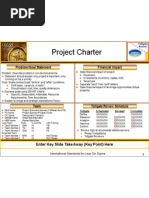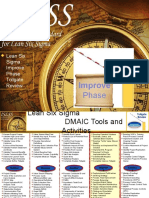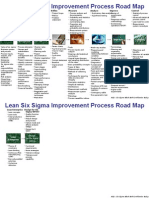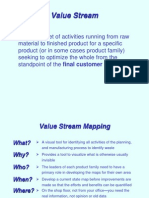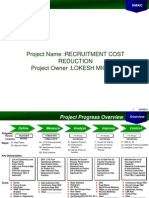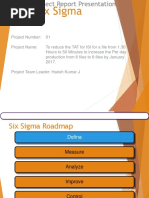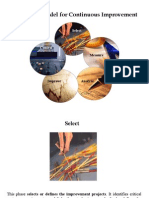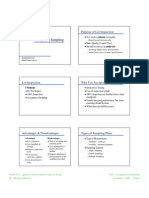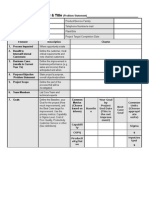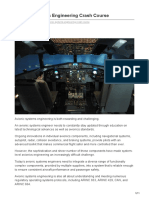0 ratings0% found this document useful (0 votes)
205 viewsSix Sigma Template Kit
Six Sigma Template Kit
Uploaded by
Silvio SchiessThis document provides templates for Six Sigma projects, including templates for defining a problem statement, objectives, benefits, process maps, cause and effect diagrams, data collection plans, measurement systems analysis, capability analysis, and solution evaluation. It outlines the Define, Measure, Analyze, Improve, Control (DMAIC) process and provides action plan and Gantt chart templates to plan and track a Six Sigma project.
Copyright:
© All Rights Reserved
Available Formats
Download as XLS, PDF, TXT or read online from Scribd
Six Sigma Template Kit
Six Sigma Template Kit
Uploaded by
Silvio Schiess0 ratings0% found this document useful (0 votes)
205 views69 pagesThis document provides templates for Six Sigma projects, including templates for defining a problem statement, objectives, benefits, process maps, cause and effect diagrams, data collection plans, measurement systems analysis, capability analysis, and solution evaluation. It outlines the Define, Measure, Analyze, Improve, Control (DMAIC) process and provides action plan and Gantt chart templates to plan and track a Six Sigma project.
Copyright
© © All Rights Reserved
Available Formats
XLS, PDF, TXT or read online from Scribd
Share this document
Did you find this document useful?
Is this content inappropriate?
This document provides templates for Six Sigma projects, including templates for defining a problem statement, objectives, benefits, process maps, cause and effect diagrams, data collection plans, measurement systems analysis, capability analysis, and solution evaluation. It outlines the Define, Measure, Analyze, Improve, Control (DMAIC) process and provides action plan and Gantt chart templates to plan and track a Six Sigma project.
Copyright:
© All Rights Reserved
Available Formats
Download as XLS, PDF, TXT or read online from Scribd
Download as xls, pdf, or txt
0 ratings0% found this document useful (0 votes)
205 views69 pagesSix Sigma Template Kit
Six Sigma Template Kit
Uploaded by
Silvio SchiessThis document provides templates for Six Sigma projects, including templates for defining a problem statement, objectives, benefits, process maps, cause and effect diagrams, data collection plans, measurement systems analysis, capability analysis, and solution evaluation. It outlines the Define, Measure, Analyze, Improve, Control (DMAIC) process and provides action plan and Gantt chart templates to plan and track a Six Sigma project.
Copyright:
© All Rights Reserved
Available Formats
Download as XLS, PDF, TXT or read online from Scribd
Download as xls, pdf, or txt
You are on page 1of 69
Six Sigma Templates
Six Sigma Templates
Six Sigma Templates
Six Sigma Templates
Breakthrough Strategy
Step MAIC Focus Action Question
1 Measure CTQ Select CTQ Characteristic
Does the selected CTQ offer high impact --
quality, cost or time ?
2 Measure CTQ Define Performance Standards
Can stated performance standards satisfy
customer and business needs?
3 Measure CTQ Validate Measurement System
Is the current measurement system
acceptable by conventional standards?
4 Analyze CTQ Establish Product Capability
Does the existing capability of this CTQ need
to be improved to meet performance
requirements?
5 Analyze CTQ Define Performance Objectives
Do we know the extent to which the variation
must be reduced to meet objectives?
6 Analyze CTQ Identify Variation Sources Do we know the major family of variation?
7 Improve
CTQ and CTP
(Critical to
Process)
Screen Potential Causes Are the leverage CTP's known?
8 Improve
CTQ and CTP
(Critical to
Process)
Study Key Relationships
Do we know what relationships among the
CTP's must be controlled ?
9 Improve CTP Establish Operating Tolerances
Do we know the functional limits for the
CTP's?
10 Control CTP Validate Measurement System (for X's)
Is the current measurement systems
acceptable by conventional standards for the
CTP's?
11 Control CTP Determine Process Capability (Y and X's)
Can process operate within chosen limits to
a 6s capability?
12 Control CTP Implement Process Control System Can objectives be consistently met?
Page 5
Breakthrough Strategy
Know See Tool
Selection critieria and timeframe Decision Matrix
Brainstorming, pareto, C&E analysis,
process/design FMEA, COPQ, RTY, dpu,
Y.norm
Mean, target, Spec Limits, functional limits,
required capability
Graphical presentation of requirements
Communication with customers, Strat Plan,
Design specifications
P/T and R&R values GRR Table Gage R&R spreadsheet
Baseline m, s, Cp, Cpk, Pp, Ppk
Minitab Capability Six Pack and Six Sigma
Macro Reports
Minitab
Baseline and target m, s, Cp, Cpk, Pp, Ppk Picture of "is" and "ought" Minitab
Inputs, noise variables
Process Map and capabilities of each input
variables
Process Map, FMEA, Cause and Effect
Matrix, Multivari chart
Direction of effect and sensitivity of selected
CTP's with respect to m, s
Graphical and tabular form
Main Effects Plot, ANOVA, e (SSe/SSt),
Autocorrelation, Regression
Main effects, Interactions, clear of
confounding
Graphical and tabular form
Main Effects Plot,Interaction Plots, ANOVA,
e (SSe/SSt), Autocorrelation, Regression
Regression coefficients and coding
information
Equation and graphical
Main effects plots, regression, interactions
plot
P/T and R&R values GRR Table Gage R&R spreadsheet
Baseline m, s, Cp, Cpk, Pp, Ppk
Minitab Capability Six Pack and Six Sigma
Macro Reports
Minitab
Control charts, CTQ yield information Six Sigma Reports Six Sigma Macro, control chart option
Page 6
Breakthrough Strategy
Data Location
Continuous and discrete data, Spec Limits
for short term,
Simulator, QA/QC, Manufacturing
Reliability and warranty data, engineering
data, Mean, Standard Deviation, Spec Limits
for short term
Simulator
Sample Data over process range Lab/Floor
n= 500 subgroups = 100 subgroup
size = 5, record Y and X's for future use
Simulator
From capability analysis and performance
standards
Previous outputs
Process understanding Grey Matter
Data from product capability study
Sample Data over process range Shop floor
Rational subgroups of continuous data Shop floor
Page 7
Six Sigma Project Template
Project Name
Group Name Black Belt Name
Department Name Team Members
Project Champion Name
Process Owner Name
Total FTE's Performing Process
Total Cost of Process (000's)
Problem Statement
Provide complete and detailed description
State the Defect or Undesired Event
Exclude solutions
Do not include causes
Review with Finance
Define measurement source
Include Baseline data (if available)
IncludeTimeframe
Include conditions surrounding problem
Project Objective/Desired State State the Project Objective/Desired State and make sure it links back to the Problem Statement
Clearly define and quantify
70% Defect Reduction Sought
Include Entitlements - Best Performance
Include available benchmark data
Benefits ($000's)
Include Shareholder/Cost Benefits
Include Client Service Benefits - Intrnl/Ext
Employee Benefits
Dependencies
Significant Systems Development
Major Capital Investment
External Considerations
Potential to Leverage
Other Information Include any other information related to the Project as necessary
Cost Benefits outside of Group
State the Problem/Defect
Other Cost Savings
Description:
State the Project Objective
Total Cost Benefits $0
Employee Benefits
Client/Employee Benefits
Internal/External Client Benefits
Cost of Defect
Cost Benefits
Description:
Revenue
FTE Cost Savings
Defect FTE's (if app.)
Can project be performed in 4 months?
Yes No
SS Project Plan Six Sigma Project Template 5/30/2014
What How Who
(Action to Take) (Action Steps) (Accountable) Start Finish
Project Action Plan
Project
Process Owner
When Deliverables
Black Belt
Date
Project Name:
Project Description:
Project Managers:
Date:
How to Satisfy Wants
What the customer wants
Total
Critical to Quality Characteristics
Suppliers Input Process (High Level) Output Customers
1 1 Start Point: 1 1
2 2
3 2 1
2 1 2
2 3 1
3 1 2
3 1 2 4 1
2 3 2
3 4 5 1
4 1 5 2
2 6 6 1
3 7 2
8
9
10
11
End Point:
Operation or Activity
Who are the customers
SIPOC
Who are the What do the suppliers provide to my process? What are the start and end What product or service does the process
Suppliers Inputs Outputs
(Providers of the required
resources)
(Resources required by the
process) (Deliverables from the process)
Requirements Requirements
Process Customers
(Top level description of the
activity)
(Anyone who receives a
deliverable from the process)
Process Name (& boundaries):
Process Owner(s):
Step No. Activity Responsible Volume No. Total hrs NVA NVA hrs/
position per week individuals per week (Y/N?) week
(1) (2) (3) (4) (5) (6) (7) (8)
Sum=
Process Analysis Worksheet
Management Man Method
Measurement Machine
Material
Cause
Cause
Cause
Cause
Cause
Cause
Cause
Cause
Cause
Cause
Cause
Effect
(Y)
Method
Material
Cause
Brainstorm Potential Root Causes
Problem
Statement:
Rank Potential Root Cause Supporting Data & Analysis?* Source? Who? When?
*Common types of data and analysis Analysis description:
Detailed Process Review Careful walkthrough of the process step by step to determine the source, nature and frequency of the problem
Process Mapping Detailed process flow analysis to understand all the steps of the process, how the problem occurs and to document the process flow
Visual Analysis Visual examination of the problem and visual documentation such as digital photos and videos
Cause and Effect (Event) Analysis Examination of the potential relationship of factors and or event conditions on the problem
Data Collection and Analysis Measurement of performance from the product or process and an analysis of current data and associated factor effects
Additional Tests and Experiments Additional tests or experiments designed to understand the current situation and determine the root cause
Output 1 Output 2 Output 3 Output 4 Output 5 Output 6 Output 7 Output 8 Output 9
Inputs
Wght Wght 1 2
Input 1 10 2
Input 2
Input 3
Input 4
Input 5
Input 6
Input 7
Input 8
Input 9
Input 10
Input 11
Input 12
Score 10 4 0 0 0 0 0 0 0
Outputs/ Outcomes
Function Deployment Matrix
Score
14
Function Deployment Matrix
Risk Assessment Form
List the Solution or Failure Mode Severity Probability Score Action Owner Due
Major Elements of (What can go wrong) (1-10) (10 is (High scores Plan Date
Your Solution List each failure mode 10 is Worst very probable) need attention)
1.Solution
a)
b)
c)
2. Solution a)
b)
c)
3. Solution a)
b)
Solution Evaluation Form
List Root Cause(s) List Solutions % Effect Estimated Cost Complexity Estimated Benefit Risk* Priority Validation?
Root Cause 1 Solutions 1
% of cost time or savings High Order Need
effect of effort to due to Medium of potential to
solution solution implement solution or solution verify
will have implementation short term? or Low implmentation effectiveness
on the long term? improvement 1st, 2nd, 3rd of solution
root cause in customer
satisfaction
Root Cause 2
* Use Risk Assessment Form
Data Collection Plan
Who will
Do it?
Type of Operational Measurement Data Tags Needed Data Collection Person(s) What? Where? When? How Many?
Measure Measure Definition or Test Method to Stratify the Data Method Assigned
Name of X or Y Clear definition of Visual Data tags are Manual? State What Location How The number
parameter attribute or the measurement inspection defined for the Spreadsheet? who has measure is for often of data
or condition discrete defined in such a or automated measure. Such Computer based? the being data the points
to be data, way as to achieve test? as: time, date, etc. responsibility? collected collection data collected
measured product or repeatable results Test instruments location, tester, is per sample
process from multiple are defined. line, customer, collected
data observers buyer, operator,
Procedures for etc.
data collection
are defined.
Define What to Measure Define How to Measure Sample Plan
Measure Relationships
Responses or Outputs (Ys) Factors (Xs)
Dependent Variable USL LSL Target Independent Variable(s) USL LSL Target
Project Name: Start Date: 6/10/2002
Use lines and or color bars to indicate start and stop dates for each activity
Phase: Activity Start Date End Date Assigned to: 6/10/2002 6/11/2002 6/12/2002 6/13/2002 6/14/2002 6/15/2002 6/16/2002 6/17/2002
1. Define and
Contain the
Problem
2. Measure the
Problem
3. Perform
Root Cause
Analysis
4. Plan and
Implement
Improvement
5. Assess
Effectiveness of
Improvement
6. Standardize
and Control
7. Realize and
Reflect
Root Cause Analysis Timeline
Project Name:
Phase: Activity Start Date End Date Assigned to:
1. Define and
Contain the
Problem
2. Measure the
Problem
3. Perform
Root Cause
Analysis
4. Plan and
Implement
Improvement
5. Assess
Effectiveness of
Improvement
6. Standardize
and Control
7. Realize and
Reflect
Root Cause Analysis Timeline
6/18/2002 6/19/2002 6/20/2002 6/21/2002 6/22/2002 6/23/2002 6/24/2002 6/25/2002
Root Cause Analysis Timeline
Project Name:
Phase: Activity Start Date End Date Assigned to:
1. Define and
Contain the
Problem
2. Measure the
Problem
3. Perform
Root Cause
Analysis
4. Plan and
Implement
Improvement
5. Assess
Effectiveness of
Improvement
6. Standardize
and Control
7. Realize and
Reflect
Root Cause Analysis Timeline
6/26/2002 6/27/2002 6/28/2002 6/29/2002 6/30/2002 7/1/2002 7/2/2002 7/3/2002 7/4/2002
Root Cause Analysis Timeline
Project Name:
Phase: Activity Start Date End Date Assigned to:
1. Define and
Contain the
Problem
2. Measure the
Problem
3. Perform
Root Cause
Analysis
4. Plan and
Implement
Improvement
5. Assess
Effectiveness of
Improvement
6. Standardize
and Control
7. Realize and
Reflect
Root Cause Analysis Timeline
7/5/2002 7/6/2002 7/7/2002 7/8/2002 7/9/2002 7/10/2002
Root Cause Analysis Timeline
DOE 2^2 template
2
2
Factorial Design (with up to 5 replicates)
Replications ----- ----
A B AB 1 2 3 4 5 Sum Average
-1 -1 1 28 25 27 80 26.67
1 -1 -1 36 32 32 100 33.33
-1 1 -1 18 19 23 60 20.00
1 1 1 31 30 29 90 30.00
ave - 23.3 30.0 26.7
ave + 31.7 25.0 28.3
effect 8.3 -5.0 1.7
Sources SS df MS F F table Stat sig ? a
A 208.3 1 208.33 53.2 11.2586 * 0.01
B 75.00 1 75.00 19.1 11.2586 *
AB 8.33 1 8.33 2.13 11.2586 ns
Error 31.33 8 3.92
Total 323.0 11
27.50
ANOVA
REGRESSION MODEL
Intercept
0.0
10.0
20.0
30.0
40.0
ave - ave +
A Effect
22.0
24.0
26.0
28.0
30.0
32.0
ave - ave +
B Effect
0.0
10.0
20.0
30.0
40.0
A - A +
AB Interaction
B -
B +
Page 33
DOE 2^2 template
4.167
-2.5
0
A 1
B 1
Y-hat 29.17
Actual Pred Residual rank Perc Z
1 -1 -1 28 25.8 2.167 1 2.5 -1.96
2 -1 -1 25 25.8 -0.833 16 77.5 0.755
3 -1 -1 27 25.8 1.167 5 22.5 -0.755
4 -1 -1 0 0 0.000 7 32.5 -0.454
5 -1 -1 0 0 0.000 7 32.5 -0.454
1 1 -1 36 34.2 1.833 3 12.5 -1.15
2 1 -1 32 34.2 -2.167 18 87.5 1.15
3 1 -1 32 34.2 -2.167 18 87.5 1.15
4 1 -1 0 0 0.000 7 32.5 -0.454
5 1 -1 0 0 0.000 7 32.5 -0.454
1 -1 1 18 20.8 -2.833 20 97.5 1.96
2 -1 1 19 20.8 -1.833 17 82.5 0.935
3 -1 1 23 20.8 2.167 1 2.5 -1.96
4 -1 1 0 0 0.000 7 32.5 -0.454
5 -1 1 0 0 0.000 7 32.5 -0.454
1 1 1 31 29.2 1.833 3 12.5 -1.15
2 1 1 30 29.2 0.833 6 27.5 -0.598
3 1 1 29 29.2 -0.167 15 72.5 0.598
4 1 1 0 0 0.000 7 32.5 -0.454
5 1 1 0 0 0.000 7 32.5 -0.454
B coefficient
AB coefficient
PREDICTION EQUATION
RESIDUALS
A coefficient
-4.000
-3.000
-2.000
-1.000
0.000
1.000
2.000
3.000
0 5 10 15 20 25
Page 34
DOE 2^2 template
score rank (R-0.5)/nz score
8.3 3 0.833 0.96742
-5.0 1 0.167 -0.9674
1.7 2 0.5 0
EFFECTS PLOT
0
0.1
0.2
0.3
0.4
0.5
0.6
0.7
0.8
0.9
-10.0 -5.0 0.0 5.0 10.0
Series1
Page 35
DOE 2^2 template
B - B +
A - 26.7 20
A + 33.3 30
Page 36
DOE 2^2 template
25
Page 37
DOE 2^3 template
2
3
Factorial Design (with up to 5 replicates)
Replications ----- ----
A B C AB AC BC ABC 1 2 3 4 5 Sum Average
(1) -1 -1 -1 1 1 1 -1 1 2 3 6 2.00
a 1 -1 -1 -1 -1 1 1 1 2 3 6 2.00
b -1 1 -1 -1 1 -1 1 1 2 3 6 2.00
ab 1 1 -1 1 -1 -1 -1 1 2 3 6 2.00
c -1 -1 1 1 -1 -1 1 1 2 3 6 2.00
ac 1 -1 1 -1 1 -1 -1 1 2 3 6 2.00
bc -1 1 1 -1 -1 1 -1 1 2 3 6 2.00
abc 1 1 1 1 1 1 1 1 2 3 6 2.00
ave - 2.00 2.00 2.00 2.00 2.00 2.00 2.00
ave + 2.00 2.00 2.00 2.00 2.00 2.00 2.00
effect 0.00 0.00 0.00 0.00 0.00 0.00 0.00
0.00
0.50
1.00
1.50
2.00
2.50
ave
-
ave
+
A Effect
0.00
0.50
1.00
1.50
2.00
2.50
ave - ave +
B Effect
0.00
0.50
1.00
1.50
2.00
2.50
A - A +
AB Interaction
B -
B +
0.00
0.50
1.00
1.50
2.00
2.50
ave
-
ave
+
C Effect
0.00
0.50
1.00
1.50
2.00
2.50
A - A +
AC Interaction
C-
C+
0.00
0.50
1.00
1.50
2.00
2.50
B - B +
BC Interaction
Page 38
DOE 2^3 template
Sources SS df MS F F table Stat sig ? a
A 0.00 1 0.00 0.00 8.53 ns 0.01
B 0.00 1 0.00 0.00 8.53 ns
C 0.00 1 0.00 0.00 8.53 ns
AB 0.00 1 0.00 0.00 8.53 ns
AC 0.00 1 0.00 0.00 8.53 ns
BC 0.00 1 0.00 0.00 8.53 ns
ABC 0.00 1 0.00 0.00 8.53 ns
Error 16.00 16 1.00
Total 16.00 23
2.00
0
0
0
0
0
0
0
A 1
B 1
C 1
Y-hat 2.00
ABC coefficient
REGRESSION MODEL
Intercept
A coefficient
B coefficient
PREDICTION EQUATION
C coefficient
AB coefficient
AC coefficient
BC coefficient
Page 39
DOE 2^3 template
Page 40
DOE 2^3 template
ANOVA
B - B +
A - 2.00 2.00
A + 2.00 2.00
C- C+
A - 2.00 2.00
A + 2.00 2.00
C- C+
B - 2.00 2.00
B + 2.00 2.00
C-
C+
Page 41
DOE 2^3 template
C+
Page 42
This is a simple sigma level calculator
Enter process sigma level, compute PPM
Process Sigma Level -> 6
PPM 3.4
Percent 0.00034%
Enter percent, compute PPM and process sigma level
If the percent is less than 1, you must use
the percent sign after the number (e.g.,
0.01%)
Percent -> 0.00034%
PPM 3.4
Process Sigma Level 6.0
Enter DPMO, compute process sigma level
DPMO -> 3.4
Process Sigma Level 6.0
Parts per Million Calculator
NO 1.5 SIGMA SHIFT IN THESE CALCULATIONS
Enter process sigma level, compute PPM
Process Sigma Level -> 6
PPM 0.0
Percent 0.00000%
Enter percent, compute PPM and process sigma level
Percent -> 1.00%
PPM 10000
Process Sigma Level -> 2.326
Enter DPMO, compute process sigma level
Process Sigma Level -> 4.5
DPMO 3.4
Sigma Level (no shift) Calculator
Step DPMO DPMO/1,000,000
1-(DPMO/1,000,000)
1 5,000 0.005
0.995
2 15,000 0.015
0.985
3 1,000 0.001
0.999
4 50 0.00005
0.99995
RTY= 0.99472
Rolled Throughput Yield Calculator
This template calculates the DPMO using the number of defects.
Total number of units: 2500
Number of defects: 4
Opportunities for Error in one unit: 20
DPMO = 80
Not sure of what goes into the units?
The Data Processing Dept supervisor wants to calculate the DPMO of data entry errors in her dept.
A total of 2,500 forms were processed that day, and the supervisor finds 4 fields with error.
There are 20 entry fields on each data entry form.
For this scenario:
Total number of units = 2,500
Number of defects = 4
Opportunities for error in one unit = 20
DPMO Calculator
Conversion Calculator
Defects Per
Million
Opportunities
Sigma Level
(With 1.5
Sigma
Shift)*
Cpk (Sigma
Level / 3) With
1.5 Sigma Shift*
933,200 0.000 0.000
915,450 0.125 0.042
894,400 0.250 0.083
869,700 0.375 0.125
841,300 0.500 0.167
809,200 0.625 0.208
773,400 0.750 0.250
734,050 0.875 0.292
691,500 1.000 0.333
645,650 1.125 0.375
598,700 1.250 0.417
549,750 1.375 0.458
500,000 1.500 0.500
450,250 1.625 0.542
401,300 1.750 0.583
354,350 1.875 0.625
308,500 2.000 0.667
265,950 2.125 0.708
226,600 2.250 0.750
190,800 2.375 0.792
158,700 2.500 0.833
130,300 2.625 0.875
105,600 2.750 0.917
84,550 2.875 0.958
66,800 3.000 1.000
52,100 3.125 1.042
40,100 3.250 1.083
30,400 3.375 1.125
22,700 3.500 1.167
16,800 3.625 1.208
12,200 3.750 1.250
8,800 3.875 1.292
6,200 4.000 1.333
4,350 4.125 1.375
3,000 4.250 1.417
2,050 4.375 1.458
1,300 4.500 1.500
900 4.625 1.542
600 4.750 1.583
400 4.875 1.625
230 5.000 1.667
180 5.125 1.708
130 5.250 1.750
80 5.375 1.792
30 5.500 1.833
Sigma Conversion Table
23 5.625 1.875
17 5.750 1.917
10 5.875 1.958
3 6.000 2.000
The table assumes a 1.5 sigma shift because
processes tend to exhibit instability of that magnitude
over time. In other words, although statistical tables
indicate that 3.4 defects / million is achieved when
4.5 process standard deviations (Sigma) are between
the mean and the closest specification limit, the
target is raised to 6.0 standard deviations to
accommodate adverse process shifts over time and
still produce only 3.4 defects per million opportunities.
Six Sigma Project Timeline
Project Name:
ID Task Hours Start End Status
1 Define 1 Wk 25-Sep-01 1-Oct-01 Complete
2 Measure 17 Wks 2-Oct-01 25-Jan-02 Working
4 Project Direction Meeting 1 Hrs 22-Jan-02 22-Jan-02
5 Assign Roles 5 Min 22-Jan-02 22-Jan-02
6 Review Status 10 Min 22-Jan-02 22-Jan-02
7 Review Schedule 5 Min 22-Jan-02 22-Jan-02
8 Project Direction Decision 33 Min 22-Jan-02 22-Jan-02
9 Clarify Options 10 Min 22-Jan-02 22-Jan-02
10 ID Decision Maker 2 Min 22-Jan-02 22-Jan-02
11 Vote on Options 2 Min 22-Jan-02 22-Jan-02
12 Dialog A 5 Min 22-Jan-02 22-Jan-02
13 Vote on Options 2 Min 22-Jan-02 22-Jan-02
14 Dialog B 5 Min 22-Jan-02 22-Jan-02
15 Vote on Options 2 Min 22-Jan-02 22-Jan-02
16 Decision Maker Decides 5 Min 22-Jan-02 22-Jan-02
17 Assign Tasks 5 Min 22-Jan-02 22-Jan-02
18 Work Tasks 2 Days 22-Jan-02 24-Jan-02
19 Process Map & Data Meeting 96 Min 24-Jan-02 24-Jan-02
38 Work Tasks 1 Day 24-Jan-02 25-Jan-02
39 Tollgate Review 1 Hrs 25-Jan-02 25-Jan-02
40 Analyze 2 Wks 25-Jan-02 8-Feb-02
41 FMEA Meeting 1 92 Min 25-Jan-02 25-Jan-02
50 Work Tasks 4 Days 25-Jan-02 31-Jan-02
51 FMEA Meeting 2 92 Min 31-Jan-02 31-Jan-02
60 Work Tasks 4 Days 31-Jan-02 6-Feb-02
61 FMEA and Data Analysis Meeting 78 Min 6-Feb-02 6-Feb-02
77 Work Tasks 1 Day 6-Feb-02 7-Feb-02
78 Improvement Direction Meeting 1 Hrs 7-Feb-02 8-Feb-02
91 Tollgate Review 1 Hrs 8-Feb-02 8-Feb-02
92 Improve 3 Wks 8-Feb-02 28-Feb-02
117 Control 4 Wks 28-Feb-02 28-Mar-02
Comments
Page: of
Document No:
Department Revision Date:
Storage Location Supercedes:
Responsible Storage Frequencey:
Responsible MSA
Date By %R&R P/T Disc Index
In-Service
In-Service
In-Service
In-Service
In-Service
In-Service
In-Service
In-Service
Calibration GR&R
Resoluton Bias Linearity
Calibration Procedure
Handling and Storage
Stability Date Notes
Baseline
Gage Control Plan
Gage Information
of
Personnel Information
Reference Information
Gage Type
Gage Name
Gage ID/Serial Number
Maintenance
Spare Parts
Relationship Matrix
9=Strong,
3=Moderate,
1=Weak
Q
u
a
l
i
t
y
o
f
S
e
r
v
i
c
e
S
t
a
f
f
i
n
g
L
e
v
e
l
s
C
a
l
l
V
o
l
u
m
e
C
a
l
l
R
o
u
t
i
n
g
T
r
a
i
n
i
n
g
S
y
s
t
e
m
s
P
r
o
b
l
e
m
s
I
n
f
o
r
m
a
t
i
o
n
S
o
u
r
c
e
s
:
S
p
e
e
d
/
A
v
a
i
l
a
b
i
l
i
t
y
C
a
l
l
B
l
o
c
k
i
n
g
A
v
a
i
l
a
b
i
l
i
t
y
o
f
O
t
h
e
r
D
e
p
t
s
E
x
c
e
p
t
i
o
n
P
r
o
c
e
s
s
i
n
g
R
e
w
o
r
k
R
e
d
u
c
t
i
o
n
E
x
p
e
r
i
e
n
c
e
L
e
v
e
l
o
f
R
e
p
s
D
e
l
i
v
e
r
y
o
f
I
n
f
o
T
e
c
h
n
o
l
o
g
y
L
i
m
i
t
a
t
i
o
n
s
H
o
w
I
m
p
o
r
t
a
n
t
B
a
s
e
l
i
n
e
Metric Target
Service Level
IVR Usage
Call Work
Productivity and
Calls Per Hour
Cost
Risk Exposure
Compliance
POC Resolution
Call Duration and
Hold Time
Call Backs
Call Transferred
Call Blocked
Time in Queue
How Important
0 0 0 0 0 0 0 0 0 0 0 0 0 0 0 0
Metric
Target
M
a
n
a
g
e
m
e
n
t
E
x
t
e
r
n
a
l
C
l
i
e
n
t
Rating of
Importance to
Customer
1 2 3 4 5 6 7 8 9 10 11 12 13 14 15
Process Inputs Total
1 0
2 0
3 0
4 0
5 0
6 0
7 0
8 0
9 0
10 0
11 0
12 0
13 0
14 0
15 0
16 0
17 0
18 0
19 0
20 0
0
Total
000000000000000
Cause & Effect Matrix
Page 54
PFMEA Number:
Process Name:
Process Responsibility:
Prepared By:
Affected Product(s):
PFMEA Key Date:
PFMEA Origination Date:
PFMEA Revision Date:
Core Team Members:
Potential Failure Modes and
Effects Analysis (Information
Sheet)
PFMEA Information Sheet
FMEA
Process or
Product Name:
Prepared by: Page ____ of ____
Responsible: FMEA Date (Orig) ______________ (Rev) _____________
Process Step
Key Process
Input
Potential Failure Mode Potential Failure Effects
S
E
V
Potential Causes
O
C
C
Current Controls
D
E
T
R
P
N
Actions
Recommended
Resp. Actions Taken
S
E
V
O
C
C
D
E
T
R
P
N
What is the
process step
What is the Key
Process Input?
In what ways does the Key
Input go wrong?
What is the impact on the
Key Output Variables
(Customer Requirements) or
internal requirements?
H
o
w
S
e
v
e
r
e
i
s
t
h
e
e
f
f
e
c
t
t
o
t
h
e
c
u
s
o
t
m
e
r
?What causes the Key Input to
go wrong?
H
o
w
o
f
t
e
n
d
o
e
s
c
a
u
s
e
o
r
F
M
o
c
c
u
r
?What are the existing controls and
procedures (inspection and test)
that prevent eith the cause or the
Failure Mode? Should include
an SOP number.
H
o
w
w
e
l
l
c
a
n
y
o
u
d
e
t
e
c
t
c
a
u
s
e
o
r
F
M
?What are the actions
for reducing the
occurrance of the
Cause, or improving
detection? Should
have actions only on
high RPN's or easy
fixes.
Whose
Responsible
for the
recommende
d action?
What are the completed
actions taken with the
recalculated RPN? Be
sure to include
completion month/year
0 0
0 0
0 0
0 0
0
0
0 0
0
0
0
0
0
0
0 0
0 0
0 0
Process / Product
Failure Modes and Effects Analysis
(FMEA)
Page 56
FSeverity
Effect Criteria: Severity of Effect Defined Ranking
Hazardous:
Without Warning
May endanger operator. Failure mode affects safe vehicle operation and / or
involves noncompliance with government regulation. Failure will occur WITHOUT
warning.
10
Hazardous: With
Warning
May endanger operator. Failure mode affects safe vehicle operation and / or
involves noncompliance with government regulation. Failure will occur WITH
warning.
9
Very High
Major disruption to production line. 100% of product may have to be scrapped.
Vehicle / item inoperable, loss of primary function. Customer very dissatisfied.
8
High
Minor disruption to production line. Product may have to be sorted and a portion
(less than 100%) scrapped. Vehicle operable, but at a reduced level of
performance. Customer dissatisfied.
7
Moderate
Minor disruption to production line. A portion (less than 100%) may have to be
scrapped (no sorting). Vehicle / item operable, but some comfort / convenience
item(s) inoperable. Customers experience discomfort.
6
Low
Minor disruption to production line. 100% of product may have to be reworked.
Vehicle / item operable, but some comfort / convenience item(s) operable at
reduced level of performance. Customer experiences some dissatisfaction.
5
Very Low
Minor disruption to production line. The product may have to be sorted and a
portion (less than 100%) reworked. Fit / finish / squeak / rattle item does not
conform. Defect noticed by most customers.
4
Minor
Minor disruption to production line. A portion (less than 100%) of the product may
have to be reworked on-line but out-of-station. Fit / finish / squeak / rattle item
does not conform. Defect noticed by average customers.
3
Very Minor
Minor disruption to production line. A portion (less than 100%) of the product may
have to be reworked on-line but in-station. Fit / finish / squeak / rattle item does
not conform. Defect noticed by discriminating customers.
2
None No effect. 1
Page 57
FOccurance
Probability of Failure Possible Failure Rates Cpk Ranking
Very High: 1 in 2 < 0.33 10
Failure is almost inevitable 1 in 3 0.33 9
High: Generally associated with
processes similar to previous
1 in 8 0.51 8
processes that have often failed 1 in 20 0.67 7
Moderate: Generally associated
with processes similar to
1 in 80 0.83 6
previous processes which have 1 in 400 1.00 5
experienced occasional failures,
but not in major proportions
1 in 2,000 1.17 4
Low: Isolated failures associated
with similar processes
1 in 15,000 1.33 3
Very Low: Only isolated failures
associated with almost identical
processes
1 in 150,000 1.5 2
Remote: Failure is unlikely. No
failures ever associated with
almost identical processes
1 in 1,500,000 1.67 1
Page 58
FDetection
Detection Criteria: Liklihood the existence of a defect will be
detected by test content before product advances
to next or subsequent process
Ranking
Almost Impossible Test content detects < 80 % of failures 10
Very Remote Test content must detect 80 % of failures 9
Remote Test content must detect 82.5 % of failures 8
Very Low Test content must detect 85 % of failures 7
Low Test content must detect 87.5 % of failures 6
Moderate Test content must detect 90 % of failures 5
Moderately High Test content must detect 92.5 % of failures 4
High Test content must detect 95 % of failures 3
Very High Test content must detect 97.5 % of failures 2
Almost Certain Test content must detect 99.5 % of failures 1
Page 59
Core Team: Date (Orig):
Date (Rev):
Process Step Input Output
Process
Spec
(LSL,
USL,
Target)
Cpk /
Date
(Sample
Size)
Measure
ment
System
%R&R or
P/T
Current
Control
Method
(from
FMEA)
Who Where When
Reaction
Plan
Control Plan
Current Control Plan
Prepared by: Page: of
Approved by: Document No:
Location: Approved by: Revision Date:
Area: Approved by: Supercedes:
KPOV KPIV
Measurement
Method
Who
Measures
Sub Process
Sub Process
Step
Specification
Characteristic
Specification/
Requirement
USL LSL
CTQ
Sample Size Frequency
Where
Recorded
SOP Reference
Decision Rule/
Corrective Action
Six Sigma Process Control Plan
Customer
Process Name:
Int/Ext
Prepared by: Page: of
Approved by: Document No:
Location: Approved by: Revision Date:
Area: Approved by: Supercedes:
KPOV KPIV
Measurement
Method
Who
Measures
System Failure Mode Predictor
Predictor Level
USL LSL
CTQ
Sample Size Frequency
Where
Recorded
SOP Reference
Decision Rule/
Corrective Action
Six Sigma Preventative Maintenance Plan
Customer
Process Name:
Int/Ext
Customer Requirement
(Output Variable)
Measurement
Technique
%R&R or P/T
Ratio
Upper
Spec
Limit
Target
Lower
Spec
Limit
Cp Cpk
Sample
Size
Date
Key Process Output Variable
Capability Status Sheet
Actions
Failure Mode and Effects Analysis
(Design FMEA) FMEA Number:
Page of
System/Component: Prepared by:
FMEA Date (Orig.) (Rev.)
Core Team:
ActionsTaken
S
e
v
O
c
c
u
r
D
e
t
e
c
R.
P.
N.
Current Design
Controls Detection
Potential Cause(s)/
Mechanism(s) of
Failure
Design Responsibility:
Action Results
O
c
c
u
r
Current Design
Controls Prevention
Item /
Process
Function
Potential Failure
Mode
Potential Effect(s) of
Failure
S
e
v
D
e
t
e
c
R.
P.
N.
Recommended
Action(s)
Responsibility &
Target Completion
Date
The value in the table is the right tail probability.
Hundredth place for Z-value
Z-Value 0.00 0.01 0.02 0.03 0.04 0.05 0.06 0.07 0.08 0.09
0.0 0.50000 0.49601 0.49202 0.48803 0.48405 0.48006 0.47608 0.47210 0.46812 0.46414
0.1 0.46017 0.45620 0.45224 0.44828 0.44433 0.44038 0.43644 0.43251 0.42858 0.42465
0.2 0.42074 0.41683 0.41294 0.40905 0.40517 0.40129 0.39743 0.39358 0.38974 0.38591
0.3 0.38209 0.37828 0.37448 0.37070 0.36693 0.36317 0.35942 0.35569 0.35197 0.34827
0.4 0.34458 0.34090 0.33724 0.33360 0.32997 0.32636 0.32276 0.31918 0.31561 0.31207
0.5 0.30854 0.30503 0.30153 0.29806 0.29460 0.29116 0.28774 0.28434 0.28096 0.27760
0.6 0.27425 0.27093 0.26763 0.26435 0.26109 0.25785 0.25463 0.25143 0.24825 0.24510
0.7 0.24196 0.23885 0.23576 0.23270 0.22965 0.22663 0.22363 0.22065 0.21770 0.21476
0.8 0.21186 0.20897 0.20611 0.20327 0.20045 0.19766 0.19489 0.19215 0.18943 0.18673
0.9 0.18406 0.18141 0.17879 0.17619 0.17361 0.17106 0.16853 0.16602 0.16354 0.16109
1.0 0.15866 0.15625 0.15386 0.15151 0.14917 0.14686 0.14457 0.14231 0.14007 0.13786
1.1 0.13567 0.13350 0.13136 0.12924 0.12714 0.12507 0.12302 0.12100 0.11900 0.11702
1.2 0.11507 0.11314 0.11123 0.10935 0.10749 0.10565 0.10383 0.10204 0.10027 0.09853
1.3 0.09680 0.09510 0.09342 0.09176 0.09012 0.08851 0.08691 0.08534 0.08379 0.08226
1.4 0.08076 0.07927 0.07780 0.07636 0.07493 0.07353 0.07215 0.07078 0.06944 0.06811
1.5 0.06681 0.06552 0.06426 0.06301 0.06178 0.06057 0.05938 0.05821 0.05705 0.05592
1.6 0.05480 0.05370 0.05262 0.05155 0.05050 0.04947 0.04846 0.04746 0.04648 0.04551
1.7 0.04457 0.04363 0.04272 0.04182 0.04093 0.04006 0.03920 0.03836 0.03754 0.03673
1.8 0.03593 0.03515 0.03438 0.03362 0.03288 0.03216 0.03144 0.03074 0.03005 0.02938
1.9 0.02872 0.02807 0.02743 0.02680 0.02619 0.02559 0.02500 0.02442 0.02385 0.02330
2.0 0.02275 0.02222 0.02169 0.02118 0.02068 0.02018 0.01970 0.01923 0.01876 0.01831
2.1 0.01786 0.01743 0.01700 0.01659 0.01618 0.01578 0.01539 0.01500 0.01463 0.01426
2.2 0.01390 0.01355 0.01321 0.01287 0.01255 0.01222 0.01191 0.01160 0.01130 0.01101
2.3 0.01072 0.01044 0.01017 0.00990 0.00964 0.00939 0.00914 0.00889 0.00866 0.00842
2.4 0.00820 0.00798 0.00776 0.00755 0.00734 0.00714 0.00695 0.00676 0.00657 0.00639
2.5 0.00621 0.00604 0.00587 0.00570 0.00554 0.00539 0.00523 0.00508 0.00494 0.00480
2.6 0.00466 0.00453 0.00440 0.00427 0.00415 0.00402 0.00391 0.00379 0.00368 0.00357
2.7 0.00347 0.00336 0.00326 0.00317 0.00307 0.00298 0.00289 0.00280 0.00272 0.00264
Z
2.8 0.00256 0.00248 0.00240 0.00233 0.00226 0.00219 0.00212 0.00205 0.00199 0.00193
2.9 0.00187 0.00181 0.00175 0.00169 0.00164 0.00159 0.00154 0.00149 0.00144 0.00139
3.0 0.00135 0.00131 0.00126 0.00122 0.00118 0.00114 0.00111 0.00107 0.00104 0.00100
3.1 0.00097 0.00094 0.00090 0.00087 0.00084 0.00082 0.00079 0.00076 0.00074 0.00071
3.2 0.00069 0.00066 0.00064 0.00062 0.00060 0.00058 0.00056 0.00054 0.00052 0.00050
3.3 0.00048 0.00047 0.00045 0.00043 0.00042 0.00040 0.00039 0.00038 0.00036 0.00035
3.4 0.00034 0.00032 0.00031 0.00030 0.00029 0.00028 0.00027 0.00026 0.00025 0.00024
3.5 0.00023 0.00022 0.00022 0.00021 0.00020 0.00019 0.00019 0.00018 0.00017 0.00017
3.6 0.00016 0.00015 0.00015 0.00014 0.00014 0.00013 0.00013 0.00012 0.00012 0.00011
3.7 0.00011 0.00010 0.00010 0.00010 0.00009 0.00009 0.00008 0.00008 0.00008 0.00008
3.8 0.00007 0.00007 0.00007 0.00006 0.00006 0.00006 0.00006 0.00005 0.00005 0.00005
3.9 0.00005 0.00005 0.00004 0.00004 0.00004 0.00004 0.00004 0.00004 0.00003 0.00003
4.0 0.00003 0.00003 0.00003 0.00003 0.00003 0.00003 0.00002 0.00002 0.00002 0.00002
You might also like
- LSSGB (Simplilearn, 2014) - Lesson - 1. Overview of Lean Six SigmaDocument66 pagesLSSGB (Simplilearn, 2014) - Lesson - 1. Overview of Lean Six Sigmataghavi1347No ratings yet
- Six Sigma Report Out TemplateDocument55 pagesSix Sigma Report Out TemplatemohamadNo ratings yet
- Screw Conveyor Design and DevelopementDocument42 pagesScrew Conveyor Design and DevelopementRohit Sengar100% (3)
- IASSC Lean Six Sigma Green Belt Study GuideDocument4 pagesIASSC Lean Six Sigma Green Belt Study Guidelipsy25100% (1)
- Lean Six Sigma Project Charter TemplateDocument4 pagesLean Six Sigma Project Charter TemplateSteven Bonacorsi75% (4)
- Dmaic ToolkitDocument8 pagesDmaic ToolkitHerlander FaloNo ratings yet
- DMAIC Tool SummaryDocument1 pageDMAIC Tool SummaryGautam GoyalNo ratings yet
- Six Sigma Project - Brakes India - Wall Thickness VariationDocument141 pagesSix Sigma Project - Brakes India - Wall Thickness VariationVineet GoyalNo ratings yet
- LSS Improve Tollgate TemplatesDocument41 pagesLSS Improve Tollgate TemplatesCarlos Oliver Montejano100% (1)
- Six Sigma WorksheetsDocument67 pagesSix Sigma WorksheetsPuneet SharmaNo ratings yet
- Lean Six Sigma Voice of Customer TemplateDocument7 pagesLean Six Sigma Voice of Customer TemplateSteven Bonacorsi50% (4)
- Six Sigma DMAIC RoadmapDocument2 pagesSix Sigma DMAIC RoadmapbaromanuelNo ratings yet
- Six Sigma Template KitDocument67 pagesSix Sigma Template Kitorangota100% (1)
- LSS Measure Tollgate TemplatesDocument38 pagesLSS Measure Tollgate TemplatesCarlos Oliver Montejano100% (1)
- LSSGB-template-Udemy - Black BeltDocument40 pagesLSSGB-template-Udemy - Black BeltEL Alaoui YoussefNo ratings yet
- LEAN Continuous Improvement KaizenDocument4 pagesLEAN Continuous Improvement KaizenHafis BonterNo ratings yet
- Structured Project Guide - TemplateDocument33 pagesStructured Project Guide - TemplateVarsha MalviyaNo ratings yet
- Process Mapping GuideDocument2 pagesProcess Mapping Guideshare2gain100% (4)
- Template - Lean Six Sigma Charter (EDocFind (1) (1) .Com)Document6 pagesTemplate - Lean Six Sigma Charter (EDocFind (1) (1) .Com)Dipika PandaNo ratings yet
- Lean Six Sigma Asq Road MapDocument2 pagesLean Six Sigma Asq Road Maphj100% (4)
- Project Closure: Lessons Learned Customer ImpactDocument3 pagesProject Closure: Lessons Learned Customer Impactharshad100% (1)
- LSSGB Lesson0 Course OverviewDocument16 pagesLSSGB Lesson0 Course OverviewNax ScNo ratings yet
- ASQ Six Sigma Green Belt Study GuideDocument8 pagesASQ Six Sigma Green Belt Study Guideedemeka imohNo ratings yet
- Black Belt Project Storyboard TemplateDocument27 pagesBlack Belt Project Storyboard TemplateJorge Octavio Hurtado GonzálezNo ratings yet
- Value StreamDocument16 pagesValue StreamfoofoolNo ratings yet
- Principles of Six SigmaDocument36 pagesPrinciples of Six SigmaSatish BindumadhavanNo ratings yet
- DMAIC Cost ReductionDocument50 pagesDMAIC Cost Reductionrahulkaushikddps365No ratings yet
- 2006-09 Tutorial ASQ BoKDocument45 pages2006-09 Tutorial ASQ BoKRaghavendra NarayanaswamyNo ratings yet
- A3 Project Management and Problem Solving Thinking 1. What Is An A3 Project?Document11 pagesA3 Project Management and Problem Solving Thinking 1. What Is An A3 Project?JESUSAA36No ratings yet
- Six Sigma Project Review Checklist-Define PhaseDocument2 pagesSix Sigma Project Review Checklist-Define PhasenorlieNo ratings yet
- Final PPT (Six Sigma)Document56 pagesFinal PPT (Six Sigma)Rinku KumarNo ratings yet
- Six Sigma (Green BeltDocument18 pagesSix Sigma (Green BeltKrish0% (1)
- Cost of Poor Quality COPQ CalculatorDocument2 pagesCost of Poor Quality COPQ Calculatorrgrao85No ratings yet
- Dmaic Six Sigma 1699396223Document138 pagesDmaic Six Sigma 1699396223chorouqNo ratings yet
- Six Sigma Green Belt-3Document140 pagesSix Sigma Green Belt-3SunilNo ratings yet
- Six Sigma Report - UpdatedDocument23 pagesSix Sigma Report - UpdatedHarish Kumar JNo ratings yet
- Lean Kaizen Charter WorksheetDocument9 pagesLean Kaizen Charter Worksheetdefreyn100% (1)
- Lean Six Sigma Green Belt OrientationDocument18 pagesLean Six Sigma Green Belt OrientationJyoti Thonte-BukkapatilNo ratings yet
- Six Sigma Green Belt 1. DEFINE (IASSC)Document114 pagesSix Sigma Green Belt 1. DEFINE (IASSC)kachkach zak100% (3)
- Continuous Improvement - ModelDocument12 pagesContinuous Improvement - Modelmuneerpp100% (2)
- Six Sigma Green Belt 3.ANALYSE (IASSC)Document99 pagesSix Sigma Green Belt 3.ANALYSE (IASSC)kachkach zak100% (1)
- Six Sigma Green Belt ProjectDocument9 pagesSix Sigma Green Belt ProjectabofahadNo ratings yet
- Acceptance Sampling: Purpose of Lot InspectionDocument12 pagesAcceptance Sampling: Purpose of Lot InspectionPrasoon KumarNo ratings yet
- Six Sigma Project Charter FormDocument3 pagesSix Sigma Project Charter Formapi-3760226100% (1)
- Competencies - Behavioural Guide (Core & Leadership) February 2017Document23 pagesCompetencies - Behavioural Guide (Core & Leadership) February 2017Evy HanniNo ratings yet
- Project Name: Cycle Time Reduction. Project Owner: S.N. Parmar, Ajay Kumar ChoudhariDocument50 pagesProject Name: Cycle Time Reduction. Project Owner: S.N. Parmar, Ajay Kumar Choudhariblitzkrig100% (1)
- Module 3 Matl - Measure PhaseDocument75 pagesModule 3 Matl - Measure PhaseHannah Nicdao TumangNo ratings yet
- 5 Why TrainingDocument17 pages5 Why TrainingGURMUKH SINGHNo ratings yet
- Six Sigma: Statistically Visualized: Lower Spec. Limit Upper Spec. LimitDocument6 pagesSix Sigma: Statistically Visualized: Lower Spec. Limit Upper Spec. Limitjfernandoa01No ratings yet
- LSSBB Section 1 - Ver 3.0Document106 pagesLSSBB Section 1 - Ver 3.0karansinghraiNo ratings yet
- Kaizen ExcelDocument16 pagesKaizen Excelpedro rojas rojasNo ratings yet
- E1 Lean Six Sigma Green Beltv11institute 07072023191159Document220 pagesE1 Lean Six Sigma Green Beltv11institute 07072023191159Sasha ChandNo ratings yet
- DFSS DmaicDocument21 pagesDFSS DmaicShubham AgarwalNo ratings yet
- 10 DMAIC ToolsDocument44 pages10 DMAIC ToolsdanorahhhNo ratings yet
- Gemba Overview - Sheena Butts - IIESHS - WEBINAR v1Document35 pagesGemba Overview - Sheena Butts - IIESHS - WEBINAR v1Bryan OrdialesNo ratings yet
- 6sigma - Control PhaseDocument130 pages6sigma - Control Phasesathya_145No ratings yet
- Free DMAIC Checklist Template Excel DownloadDocument5 pagesFree DMAIC Checklist Template Excel DownloadErik Leonel LucianoNo ratings yet
- Lean SixSigma GB Certification ProcessDocument12 pagesLean SixSigma GB Certification Processmusmustofa100% (1)
- Six Sigma Template Kit2Document67 pagesSix Sigma Template Kit2f20500No ratings yet
- Six Sigma Template KitDocument67 pagesSix Sigma Template KitPedro PiNo ratings yet
- # Chapter 4: Process Design and Pre Production: SupplierDocument2 pages# Chapter 4: Process Design and Pre Production: SupplierAnkit SainiNo ratings yet
- Es969 10 2020Document5 pagesEs969 10 2020laap85No ratings yet
- FMEA Nasa SpacecraftDocument12 pagesFMEA Nasa SpacecraftsashassmNo ratings yet
- Resume Supplier Quality Engineer 3 Yrs Exp Auto OEM Vinoth KumarDocument2 pagesResume Supplier Quality Engineer 3 Yrs Exp Auto OEM Vinoth KumarVinothKumarDhananjayanNo ratings yet
- Process FMEA TemplateDocument3 pagesProcess FMEA Templateibrahime mohammedNo ratings yet
- GE - Outage ScheduleDocument16 pagesGE - Outage ScheduleMohammad NasirNo ratings yet
- Whitepaper - ESS - UL1973Document12 pagesWhitepaper - ESS - UL1973jaikp56No ratings yet
- GarmentDocument10 pagesGarmentTran Quoc VietNo ratings yet
- FMEA Escova de DentesDocument8 pagesFMEA Escova de DentesramonlevsNo ratings yet
- 0401control of DocumentsDocument5 pages0401control of DocumentsSundara Rajan RamakrishnanNo ratings yet
- NASA Hazard AnalysisDocument27 pagesNASA Hazard AnalysishvananthNo ratings yet
- Maintenance Management 3 Levels - 27!08!2022Document304 pagesMaintenance Management 3 Levels - 27!08!2022mohamedelshrpeni0No ratings yet
- FMEA and CharacteristicsDocument47 pagesFMEA and Characteristicsmalbarnes100% (4)
- AIAG VDA DFMEA TrainingDocument68 pagesAIAG VDA DFMEA TrainingAtul SURVE67% (3)
- Industrial SafetyDocument65 pagesIndustrial Safetylovelyanimal.comNo ratings yet
- FMEA Types and Their UsageDocument4 pagesFMEA Types and Their UsageAnder GaragorriNo ratings yet
- Research Paper On FmeaDocument4 pagesResearch Paper On Fmeadave jinNo ratings yet
- Six Sigma Projects and Personal ExperiencesDocument194 pagesSix Sigma Projects and Personal ExperiencesHamid Khan100% (2)
- An Evaluation of The Booking System of Inday Elyssa's Catering Services and Party NeedsDocument84 pagesAn Evaluation of The Booking System of Inday Elyssa's Catering Services and Party NeedsParaisoNo ratings yet
- The House of Reliability: Ijqrm 24,4Document21 pagesThe House of Reliability: Ijqrm 24,4Leah YeungNo ratings yet
- Production Part Approval Process PPAPDocument4 pagesProduction Part Approval Process PPAPtintucinNo ratings yet
- P&G Case StudyDocument15 pagesP&G Case StudyallamelshehamyNo ratings yet
- ME2037 Maintenance EngineeringDocument46 pagesME2037 Maintenance Engineeringrp0212100% (2)
- UOS - General, Paint Audit Form - 190117 (VPS)Document34 pagesUOS - General, Paint Audit Form - 190117 (VPS)Dhananjay PatilNo ratings yet
- Fishbone and FMEA ExampleDocument5 pagesFishbone and FMEA ExamplerscyuzonNo ratings yet
- PFD Control Plan and FMEA FormatsDocument12 pagesPFD Control Plan and FMEA FormatsDINESH SHARMA100% (1)
- Avionic Systems Engineering Crash CourseDocument11 pagesAvionic Systems Engineering Crash CourseMasuda AkterNo ratings yet
- ITEM 4.5 The Design Process - Peter J Ogrodnik - Medical Device Design - Innovation From Concept To MarketDocument11 pagesITEM 4.5 The Design Process - Peter J Ogrodnik - Medical Device Design - Innovation From Concept To MarketOmar Alejandro FAUSTNo ratings yet
- Case Studies On Risk ManagementDocument63 pagesCase Studies On Risk ManagementYazidWaseem100% (4)




